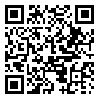Volume 4, Issue 2 (2023)
2023, 4(2): 120-135 |
Back to browse issues page
Download citation:
BibTeX | RIS | EndNote | Medlars | ProCite | Reference Manager | RefWorks
Send citation to:



BibTeX | RIS | EndNote | Medlars | ProCite | Reference Manager | RefWorks
Send citation to:
Latifi M, Mahdavinejad M. Operational Framework for Integrated Computing to Energy-Form Efficient in Architectural Design; Case Study: Isfahan Houses. Urban Design Discourse a Review of Contemporary Litreatures and Theories 2023; 4 (2) :120-135
URL: http://udd.modares.ac.ir/article-40-65572-en.html
URL: http://udd.modares.ac.ir/article-40-65572-en.html
1- Postdoctoral Researcher of Department of Architecture, Tarbiat Modares University, Tehran, Iran.Department of Architecture, Isfahan (Khorasgan) Branch, Islamic Azad University, Isfahan, Iran.
2- Professor of Department of Architecture, Tarbiat Modares University, Tehran, Iran. ,mahdavinejad@modares.ac.ir
2- Professor of Department of Architecture, Tarbiat Modares University, Tehran, Iran. ,
Abstract: (5133 Views)
Aims: Efficiency as a cultural index can be defined as the comfort resulting from the proper arrangement of components and the connection point between form and function; which plays an important role in adding quality to the space. Such an attitude to design; It is an attempt to obtain a model of valuable previous architecture to measure sustainability and discover the grammar of space in order to create works for the future of architecture.
Methods: The current research is a kind of documentary research, based on the use of data of valuable models of the past, which, by adopting a descriptive-analytical approach, analyzes the concept of efficiency in the structure of function and form in native Qajar houses of Isfahan.
Findings: Most of the massing has been done in the north (public spaces), west (service spaces), south (private spaces) and east (service spaces) fronts, respectively. Also, the data obtained from Ecotect software shows that the best direction in Isfahan city is between 17.5 degrees southwest and 22.5 degrees southeast. However, the frequency of Isfahan Orientation in the native Qajar houses of Isfahan is very low, and the emphasis is on the orientation in the north-south direction, and the southeast or southwest of it has not been given much attention.
Conclusion: The configuration of the space, the amount of received energy and the visual communication of the environment (sight) are among the indicators that affect the efficiency, which is understood by the way of massing, spatial relations and spatial proportions.
Methods: The current research is a kind of documentary research, based on the use of data of valuable models of the past, which, by adopting a descriptive-analytical approach, analyzes the concept of efficiency in the structure of function and form in native Qajar houses of Isfahan.
Findings: Most of the massing has been done in the north (public spaces), west (service spaces), south (private spaces) and east (service spaces) fronts, respectively. Also, the data obtained from Ecotect software shows that the best direction in Isfahan city is between 17.5 degrees southwest and 22.5 degrees southeast. However, the frequency of Isfahan Orientation in the native Qajar houses of Isfahan is very low, and the emphasis is on the orientation in the north-south direction, and the southeast or southwest of it has not been given much attention.
Conclusion: The configuration of the space, the amount of received energy and the visual communication of the environment (sight) are among the indicators that affect the efficiency, which is understood by the way of massing, spatial relations and spatial proportions.
Keywords: Efficiency, Integrated Design, Efficient Space System, Orientation in Isfahan, Intermediate Space
Article Type: Original Research |
Subject:
Culture and Identity in the City
Received: 2022/11/21 | Accepted: 2023/01/16 | Published: 2023/09/1
Received: 2022/11/21 | Accepted: 2023/01/16 | Published: 2023/09/1
Send email to the article author
| Rights and permissions | |
 |
This work is licensed under a Creative Commons Attribution-NonCommercial 4.0 International License. |








